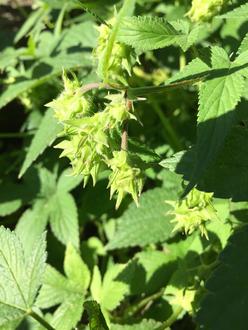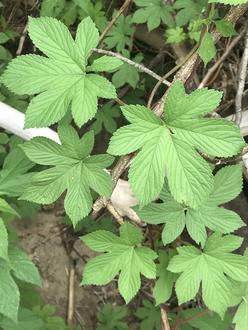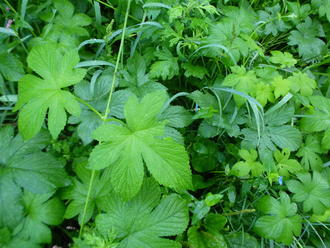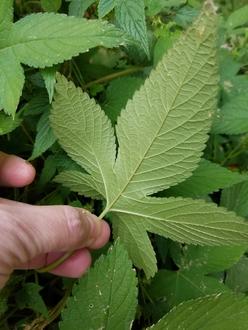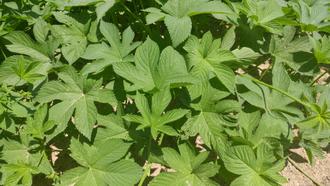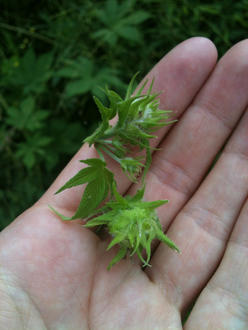Japanese Hop (Humulus japonicus Siebold & Zucc.)
Also known as Japanese hops; also classified as Humulus scandens.
↑Summary
An annual vine native to east Asia, invasive at numerous locations across eastern North America, especially in the northeast.
↑Description & Identification
An annual vine with opposite leaves with serrated margins, leaves tending to be 7-lobed, occasionally 5-lobed. Stems bear minute backwards-facing barbs that lead them to be abrasive to the touch in one direction.
↑Similar Plants
↑Habitat
In North America, mostly found in riparian areas, in areas with high light and moisture conditions, particularly with moist, exposed soil, especially adjacent to a slope. Tolerates a wide range of soil types, including sand, clay, and gravel, but grows best in fertile loam.
More common in anthropogenic habitats, such as parks in riparian areas, where human activities clear vegetation and result in the exposed soil that allows it to get established.
↑Life Cycle
Seeds germinate in spring, after a period of cold dormancy, in conditions where moist soil is exposed to sunlight. Germination is opportunistic; it may begin in early spring but may continue later.
Growth is rapid, but is hindered by shade from tree canopies. Plants will climb over and overtake low-growing vegetation. Growth is particularly good where plants are able to root in fertile soil and then climb onto drier, rockier, or otherwise poorer soils where there is more sunlight and less competition from other plants. Plants also effectively climb fences and other human structures. Vines climb by a combination of twining around supports, and tiny, sharp, backwards-facing barbs along the stem that prevent the stem from slipping downward as it climbs textured surfaces.
This species is dioecious, with separate female and male plants. Flowers are wind-pollinated.
Plants usually set seed in the fall and die down by winter, but in the warmest parts of its range, they may overwinter. Seed dispersal is likely aided by water.
↑Faunal Associations
Some bees collect pollen from the male flowers, but generally do not pollinate the plant as they do not visit the female flowers. Larvae of several caterpillars that feed on related plants, eat the foliage. There are also a number of other insect herbivores that eat this plant along with other hop (Humulus) species.
↑Control
This plant can be easily controlled if it is spotted early on in the growing season, but it can quickly cause a major infestation if it is allowed to grow unchecked and produce large volume of seed. Wearing gloves and long sleeves, taking care to not leave any skin exposed, is crucial when working with this plant, as its stems and leaves can easily cause painful abrasion to the skin.
Plants that sprout early in the season can be uprooted by hand in order to prevent them from spreading and covering a large area.
Later in the season, when growth is already vigorous, this plant can be effectively controlled by cutting off the base of the stem, disconnecting the vine from its root system. The above-ground portion will die before the plant is able to set seed.
↑Uses
This plant was introduced to North America for medicinal purposes and as an ornamental plant, but it is not usually planted any more due to its invasive nature. Unlike the common hop, it is not used in the flavoring of beer.
↑Related Plants
The common hop (Humulus lupulus) is also found in North America, introduced from Europe. This genus is also closely related to marijuana (Cannabis sativa).
In North America, the next-most-closely-related plants are hackberries (Celtis sp.), with the native common hackberry (Celtis occidentalis) overlapping the most with this species in range.
Slightly less closely related are plant of the nettle and mulberry families.
↑Notes
The pollen of this species can act as an allergen in some people.
↑Links & External Resources
• Humulus japonicus (Japanese Hops) | Illinois Wildflowers (About This Site)
• Humulus japonicus (Japanese Hop) | USDA PLANTS Database (About This Site)
• Humulus japonicus | Go Botany (About This Site)
• Humulus japonicus | Biota of North America Project (BONAP) (About This Site)
• Humulus japonicus | NatureServe Explorer (About This Site)
• Humulus japonicus | Flora of North America (About This Site)
• Humulus japonicus | Missouri Plants (About This Site)
• Japanese Hops | Maryland Biodiversity Project (About This Site)
• Humulus japonicus (Japanese Hops) | Minnesota Wildflowers (About This Site)
• Humulus japonicus Sieb. & Zucc. (Japanese Hops) | Digital Atlas of the Virginia Flora (About This Site)





